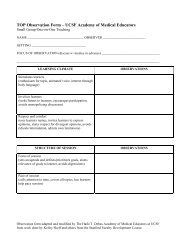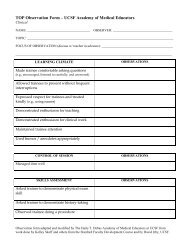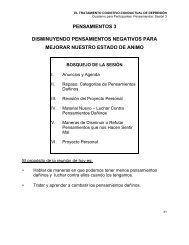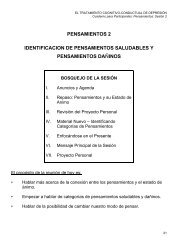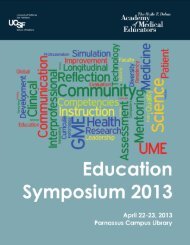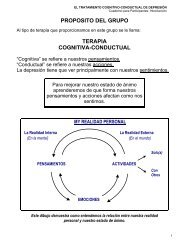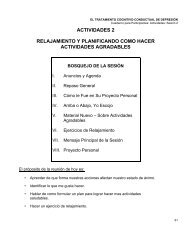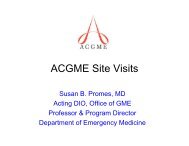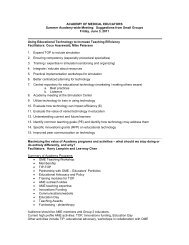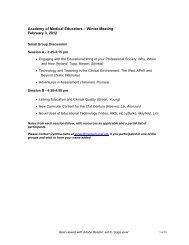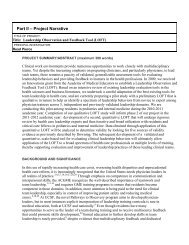2011 - UCSF School of Medicine - University of California, San ...
2011 - UCSF School of Medicine - University of California, San ...
2011 - UCSF School of Medicine - University of California, San ...
Create successful ePaper yourself
Turn your PDF publications into a flip-book with our unique Google optimized e-Paper software.
<strong>UCSF</strong> Education Day <strong>2011</strong>Methods: An anonymous, 5-item Web-based surveywas e-mailed to clinical faculty <strong>of</strong> a liver transplantrotation. Items solicited opinions about the educationalvalue <strong>of</strong> overnight call, adequacy <strong>of</strong> supervision and thevalue <strong>of</strong> a rotation without overnight call. Answer choiceswere yes/no or multiple choice and includedopportunities for comment. Analyses were descriptiveand qualitative.Results: 10/15 (67%) faculty completed the survey. Allrespondents answered that overnight call waseducationally important for the PGY-1 resident and allfelt that adequate supervision was available. In a rotationwithout overnight call, 90% <strong>of</strong> respondents answeredthat weekend coverage remained educationallyimportant but most felt this did not replace theeducational value <strong>of</strong> overnight call. Respondentsidentified the following competencies learned fromovernight call: development <strong>of</strong> independence,confidence, responsibility, decision-making, prioritizationand communication; cross-covering; and the opportunityto work-up new admissions.Discussion: Despite the scheduling difficulties imposedby new duty hours regulations, overnight call maintains aunique learning experience that should be preservedwhere possible in the training <strong>of</strong> PGY-1 residents.Reflective critique: Survey results were reported to theInternal <strong>Medicine</strong> Residency Program with a proposal tomaintain overnight call if possible, with weekend day asan educationally important, although qualitatively inferior,alternative.References:1. Nasca TJ, Day SH, Amis ES. The new recommendations on dutyhours from the ACGME task force. N Engl J Med 2010;363(2):e3.The <strong>UCSF</strong> Geriatric CommunityResources Clinical Algorithm andGuideChristopher A. Bautista, Christopher.Bautista@ucsf.edu;Louise Aronson, MD, aronsonl@medicine.ucsf.eduBackground: Roughly half <strong>of</strong> current physician visits inmany specialties are from patients >65 years old, andthe population aged >60 is expected to double by 2050.As states increasingly cut services keeping elderlypatients healthy and independent, healthcare providersmust be aware <strong>of</strong>, refer to, and lobby for these vitalgeriatric community resources.Methods: Following a literature review, internetsearches and interpr<strong>of</strong>essional expert focus groups, wedeveloped an algorithm and related guide detailingservices, eligibility, coverage and cost, provider role andlocal contacts. Validity was established through surveys<strong>of</strong> students, residents, faculty and local communityproviders as well as feedback from over 30interpr<strong>of</strong>essional national leaders in Geriatrics. Casebasedpre/post-tests with medical students and residentswere used to evaluate the educational utility <strong>of</strong> the toolsafter a brief introduction.Results: 58% (37/64) <strong>of</strong> survey respondents said thatthey were “somewhat likely” or “very likely” to use thesetools in their clinical practice and teaching. 63% (26/41)<strong>of</strong> learners “agreed” or “strongly agreed” that the toolsmade them more comfortable referring elderly patients tocommunity resources. 64% (9/14) <strong>of</strong> medical studentsand 90% (4/5) <strong>of</strong> residents who completed the pre/posttestscored higher after brief training with the tools.Discussion: The Geriatric Community ResourcesClinical Algorithm and Guide providers a validated andeducationally effective framework to help cliniciansappropriately refer elderly patients to vital communityservices. The tool alone does not help all trainees, some<strong>of</strong> whom may require a dedicated educational sessionon the purpose and uses <strong>of</strong> certain resources.Reflective critique: Presentations at ESCAPE,Geriatrics WIP and dissemination to local and nationalgeriatrics leaders for review led to additional resourcesand refined structure.Areas abstract covers: UME, GME, CME, IPHEDomain(s) addressed: Community <strong>Medicine</strong>,Evaluation <strong>of</strong> Programs and Curricula, Patient Care,Primary CarePurpose: To develop a tool that gives providers apractical conceptual framework for approaching themyriad resources necessary to keep elderly patientshealthy and independent in the community.40 The Haile T. Debas Academy <strong>of</strong> Medical Educators



